La Vierge intime dans Florence de la Renaissance: dévotion, tendresse et image domestique
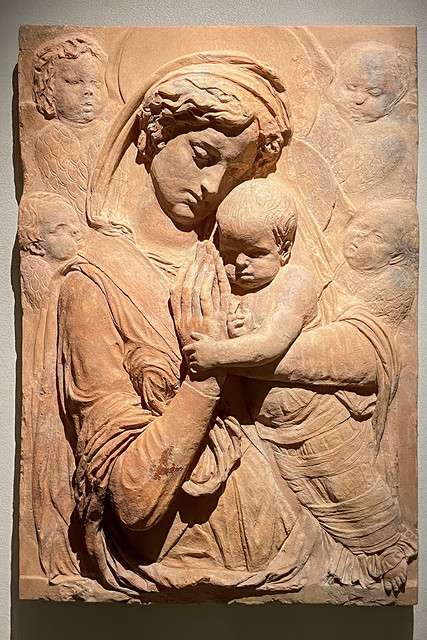
Au XVe siècle à Florence, l'image de la Vierge à l'Enfant connut une transformation discrète mais profonde. De la solennité hiératique de l'art gothique tardif, la Vierge évolua vers une vision d'une tendre humanité – non plus distante et impassible, mais proche, émouvante et profondément accessible. Ce changement reflétait une évolution plus large des pratiques dévotionnelles : un passage de la grandeur publique à l'intimité du foyer, où la foi se vivait à travers la réflexion personnelle et l'affection familiale.
Les petits reliefs sculptés,modestes par leur taille mais riches en émotions, devinrent le support idéal de cette nouvelle spiritualité. Ils invitaient non pas à la crainte révérencielle mais à l'empathie, non pas à une vénération distante mais à une contemplation directe et tendre.
Les débuts à Florence : Michelozzo et l'école de Donatello
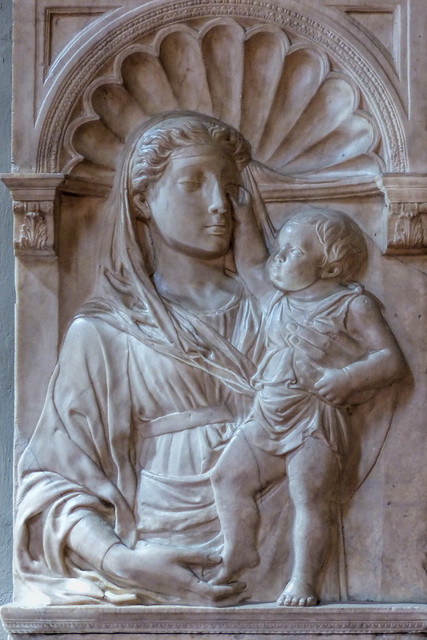
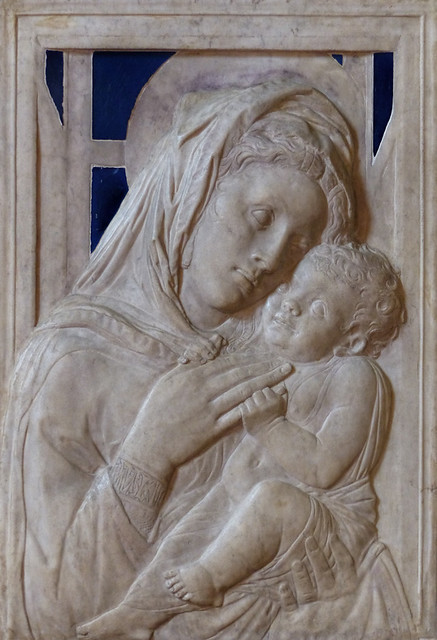
Deux bas-reliefs de jeunesse conservés au Musée national du Bargello, datant tous deux d'environ 1430, marquent ce moment charnière.
La Vierge à l'Enfant de Michelozzo di Bartolomeo révèle l'influence persistante du gothique, adoucie par l'harmonie du début de la Renaissance. La Vierge, inscrite dans un cadre architectural peu profond, incline doucement la tête vers son fils. La simplicité du trait et la géométrie maîtrisée confèrent à la composition une dignité sereine, tandis que le regard de la Vierge y introduit une note de réalisme émotionnel. Le sacré, pour la première fois, s'anime.
De la même période, la Vierge à l'Enfant Bargello commissioned by Bartolommeo Pitti et attribuée à l'école de Donatello traduit cette tendresse naissante en une expression émotionnelle plus profonde. La tête inclinée de la Vierge, ses yeux mi-clos et le doux contact de sa main sur la poitrine de l'Enfant reflètent le nouveau naturalisme spirituel de Donatello. Le cadre architectural demeure, mais l'interaction entre la mère et l'enfant devient plus immédiate, plus humaine.
Ensemble, ces deux œuvres se situent au seuil de l'esprit de la Renaissance : Michelozzo représentant la retenue classique des formes, l'école de Donatello anticipant la profondeur expressive qui allait définir la génération suivante.
Donatello et l'Humain Sacré
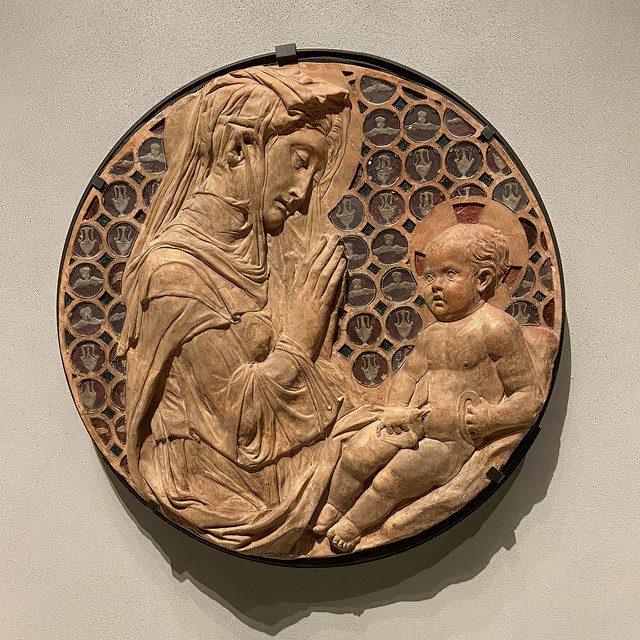
Vers 1440, de Donatello la Vierge adorant l'Enfant avec un oiseau, porte cette nouvelle vision jusqu'à sa pleine maturité. Grâce à sa technique innovatrice du stiacciato, une sculpture d'une extrême finesse qui capte la lumière comme un dessin, Donatello transforme le marbre en une pure méditation. La Vierge se penche en prière sur son fils, qui tient un petit oiseau, symbole de sa Passion future. L'échange entre eux est à la fois intime et profond : une tendresse maternelle mêlée à la prescience divine.
Les reliefs de Donatello révolutionnent la sculpture religieuse, donnant une forme physique à une foi enracinée dans le sentiment humain. Son influence se répand à travers Florence, redéfinissant la dimension émotionnelle de l'art religieux pour des décennies.
Diffusion et continuité: Antonio di Chellino da Pisa
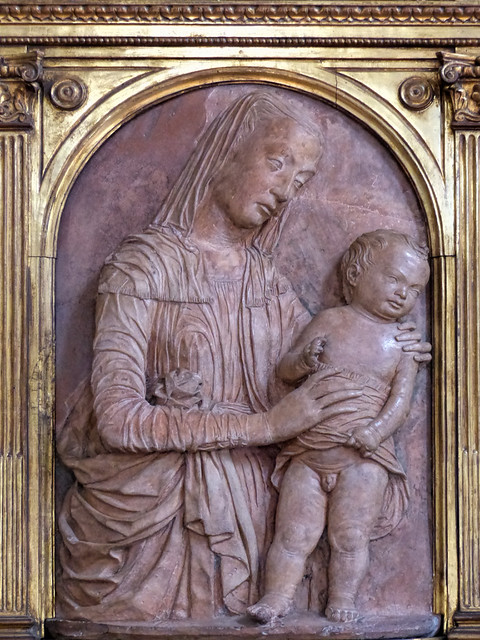
Au milieu du XVIe siècle, le style de Donatello était devenu le langage commun de la dévotion florentine. Antonio di Chellino da Pisa (actif vers 1430-1460) travailla dans l'entourage de Donatello dans les années 1440, notamment comme assistant au registre de documents à la chaire du Prato (1434-1438) et probablement aussi travailla à l'ancienne sacristie de San Lorenzo, à Florence. La Vierge à l'Enfant d'Antonio (vers 1450, Bargello, Florence) témoigne de cette diffusion. La Vierge soutient délicatement l'Enfant Jésus, debout sur un rebord, dans un cadre doré en arc de cercle. L'Enfant, le regard légèrement tourné vers l'extérieur, est bercé par une tendre retenue, incarnant une intimité maternelle sereine et une grâce dévotionnelle.
Ces petits reliefs étaient destinés à la prière familiale plutôt qu'au culte public, devenant les pièces maîtresses d'une nouvelle forme de foi privée. Dans les foyers florentins, la sculpture remplaçait l'autel : l'art comme présence, contemplation et réconfort.
Le culte de la tendresse: Desiderio, Rossellino et Benedetto da Maiano
Sous le pinceau de Desiderio da Settignano, d'Antonio Rossellino et de Benedetto da Maiano, ce mode de dévotion atteint une dimension poétique.
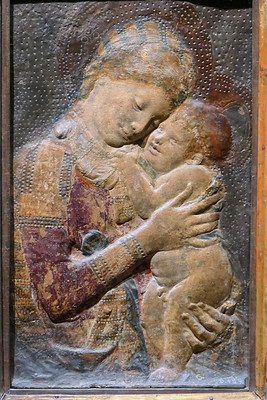
La Vierge à l'Enfant de Desiderio (vers 1450-1500, Musée des Beaux-Arts de Lyon) saisit l'affection maternelle dans toute son intimité. Le visage de la Vierge se niche contre celui de son fils, ses traits adoucis par la lumière. La sculpture de Desiderio, à la fois tendre et précise, métamorphose le marbre en chair et en os.
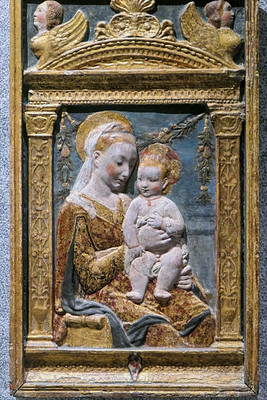
La Vierge à l'Enfant devant la guirlande de Rossellino (vers 1450-1500, Musée des Beaux-Arts de Lyon) enrichit le décor sans en altérer la force émotionnelle. La guirlande de fruits qui entoure les personnages évoque l'abondance divine, tandis que leur douce étreinte incarne la joie spirituelle et la tendresse humaine intimement liées.
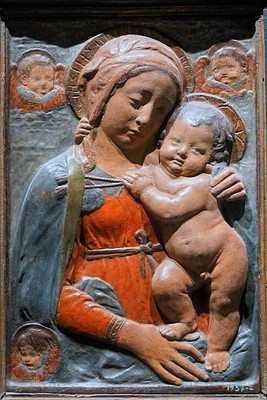
La Vierge à l'Enfant de Benedetto da Maiano (Musée des Beaux-Arts de Lyon) préfigure la monumentalité de la Haute Renaissance. L'élégance classique et la sérénité intérieure de la Vierge traduisent un équilibre harmonieux entre beauté idéale et ferveur dévotionnelle.
Ensemble, ces sculpteurs ont façonné la Madone domestique, image archétypale de la piété privée florentine. L'art et la foi se rencontraient ainsi au sein du foyer : le marbre comme réceptacle de l'affection, la sculpture comme forme de prière.
La foi au foyer: la dévotion domestique florentine
Dès le milieu du XVe siècle, ces bas-reliefs étaient devenus des éléments incontournables de la dévotion domestique florentine. Les familles les plaçaient au-dessus des cheminées ou des lits, où ils sanctifiaient le quotidien. Ils servaient à la fois d'images de prière et de reflets de la vertu morale. La douce étreinte de la Vierge Marie faisait écho aux valeurs d'amour, de sollicitude et d'humilité qui définissaient l'idéal familial de la Renaissance.
L'art et la foi se rejoignaient ainsi au sein du foyer : le marbre, réceptacle de l'affection, sculpture, forme de prière.
L'apogée de la lumière : Luca della Robbia
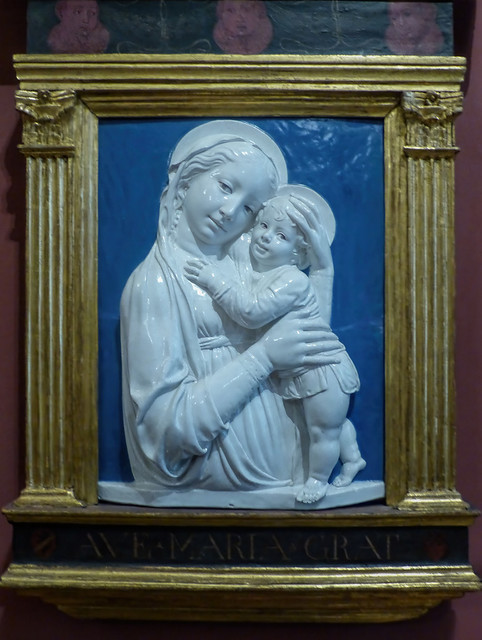
Cette évolution trouve son aboutissement radieux dans la Vierge à l'Enfant de Luca della Robbia (fin du XVe siècle, au Musée Kunsthistorisches de Vienne. L'invention par Luca de la terre cuite émaillée métamorphose l'iconographie religieuse par la couleur et la lumière. Ses figures blanches, se détachant sur un fond bleu céleste, rayonnent de pureté et de permanence. La Vierge incline tendrement la tête vers l'Enfant, qui effleure son voile d'un geste affectueux.
Accessibles, durables et lumineux, les reliefs de Luca ont introduit la beauté sacrée dans les foyers florentins à une échelle sans précédent. Son œuvre marque un aboutissement à la fois d'une manière technologique et spirituel : l'amour divin rendu par la lumière elle-même.
Le visage humain du divin
De la sobriété de Michelozzo à l'éclat éthéré de Luca della Robbia, le relief de la Vierge à l'Enfant illustre l'humanisation du sacré dans la Florence de la Renaissance. Ces œuvres ne sont pas de simples jalons stylistiques ; elles témoignent d'une transformation de la foi elle-même.
Ici, le divin n'est plus lointain ni abstrait ; il se manifeste dans le contact, dans le regard, dans l'espace tendre entre une mère et son enfant. À travers le marbre, la terre cuite et l'émail, les sculpteurs florentins ont saisi la vérité la plus profonde de la dévotion de la Renaissance : le visage de Dieu se révèle dans la chaleur de l'amour humain.
